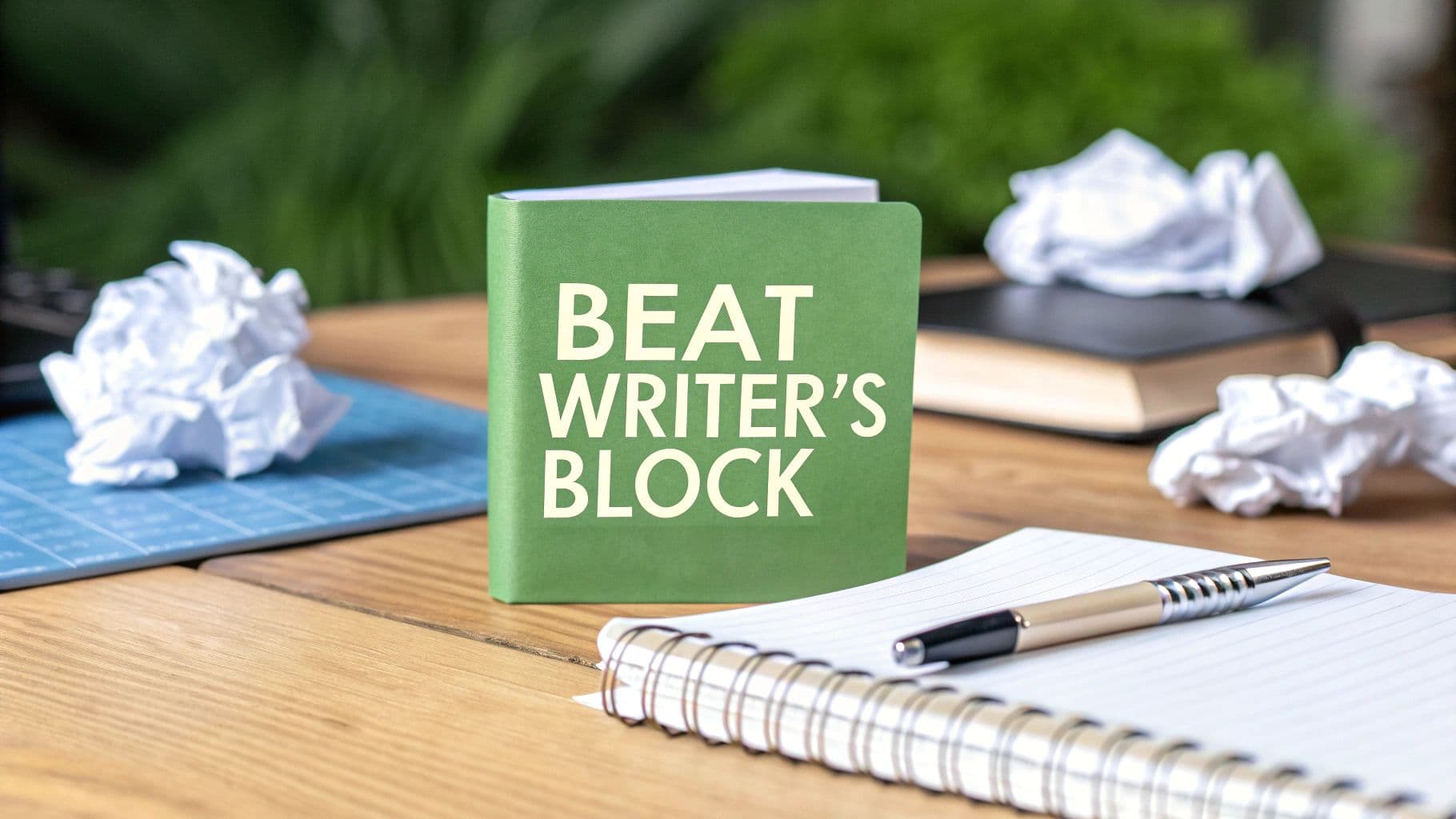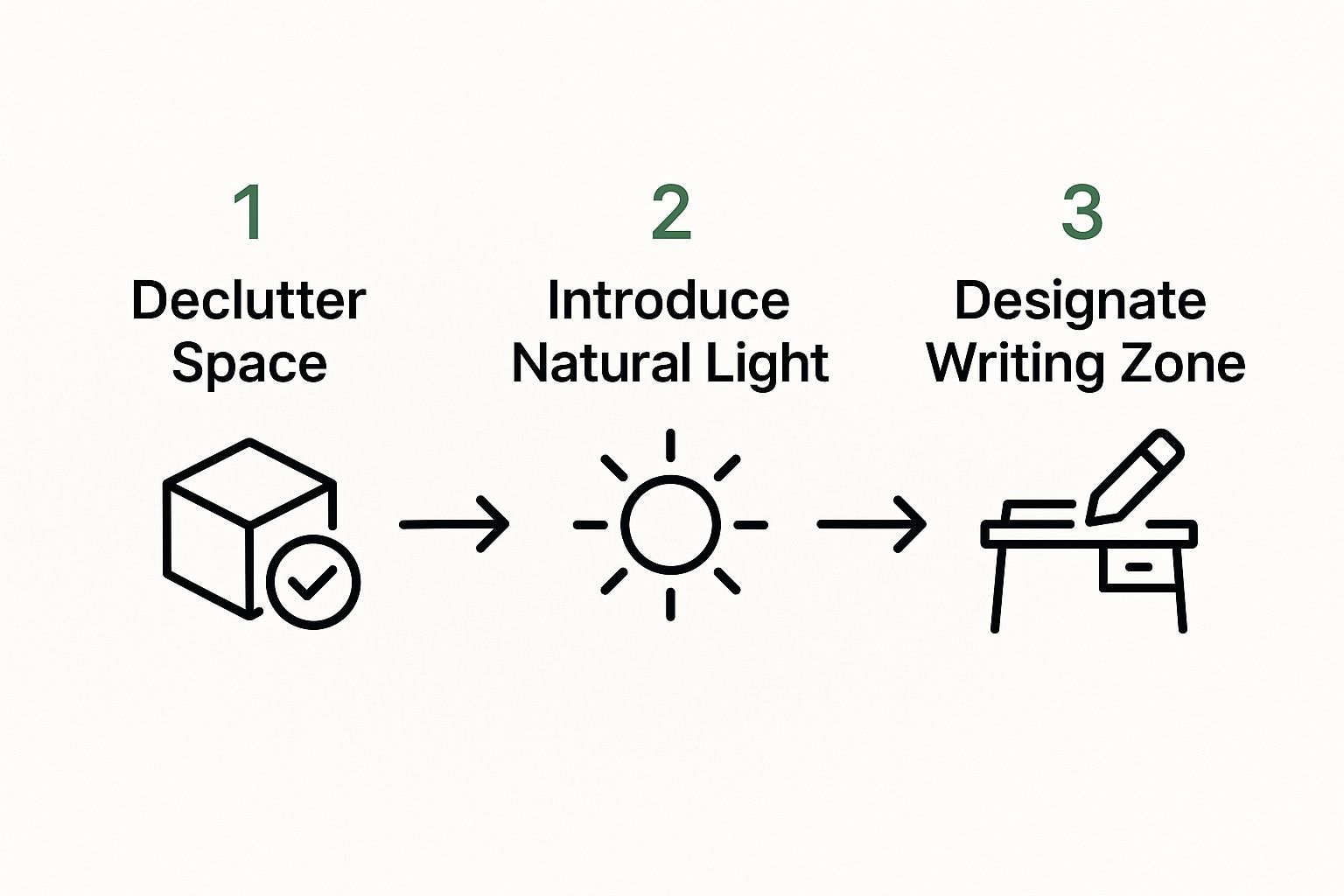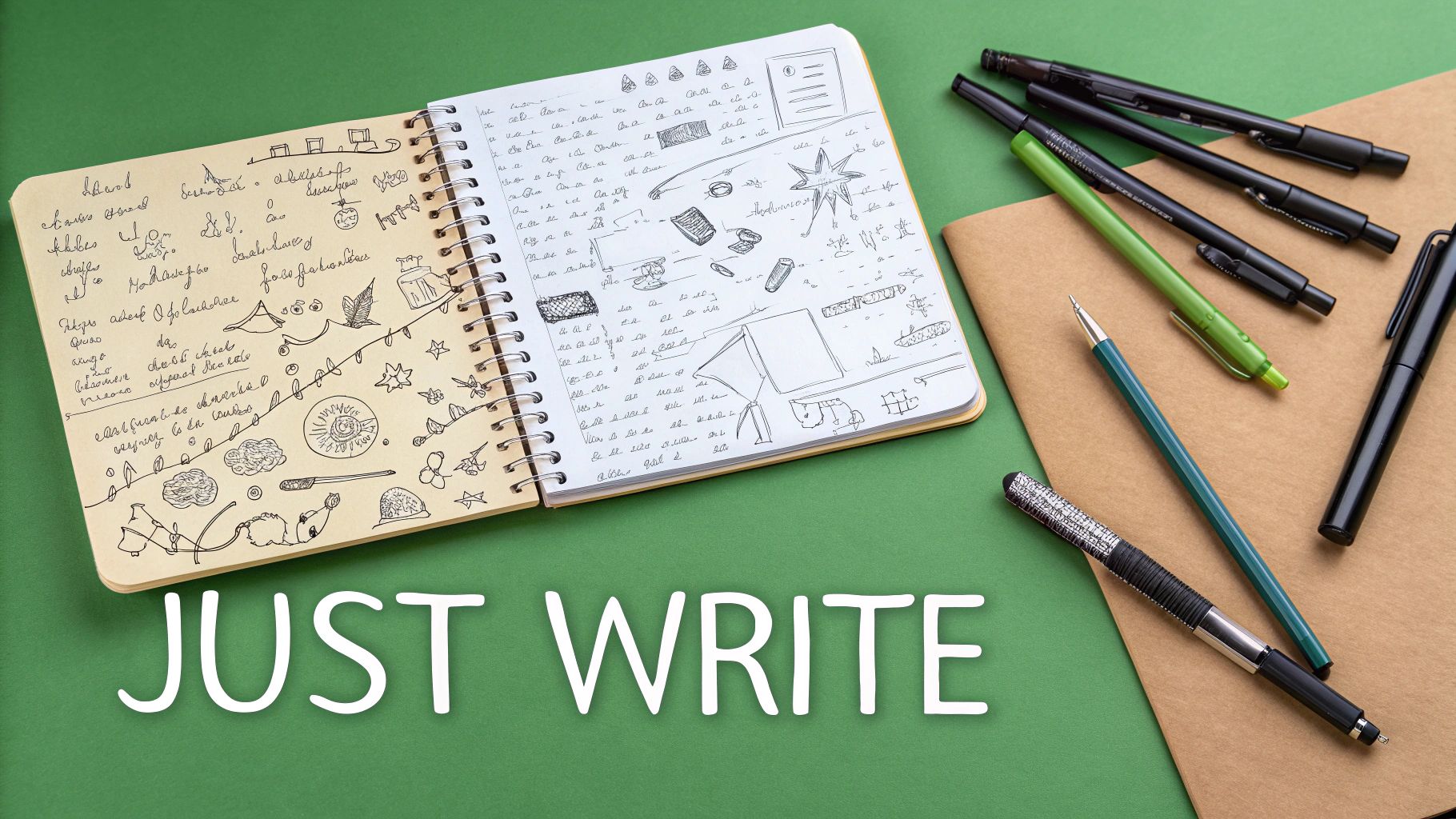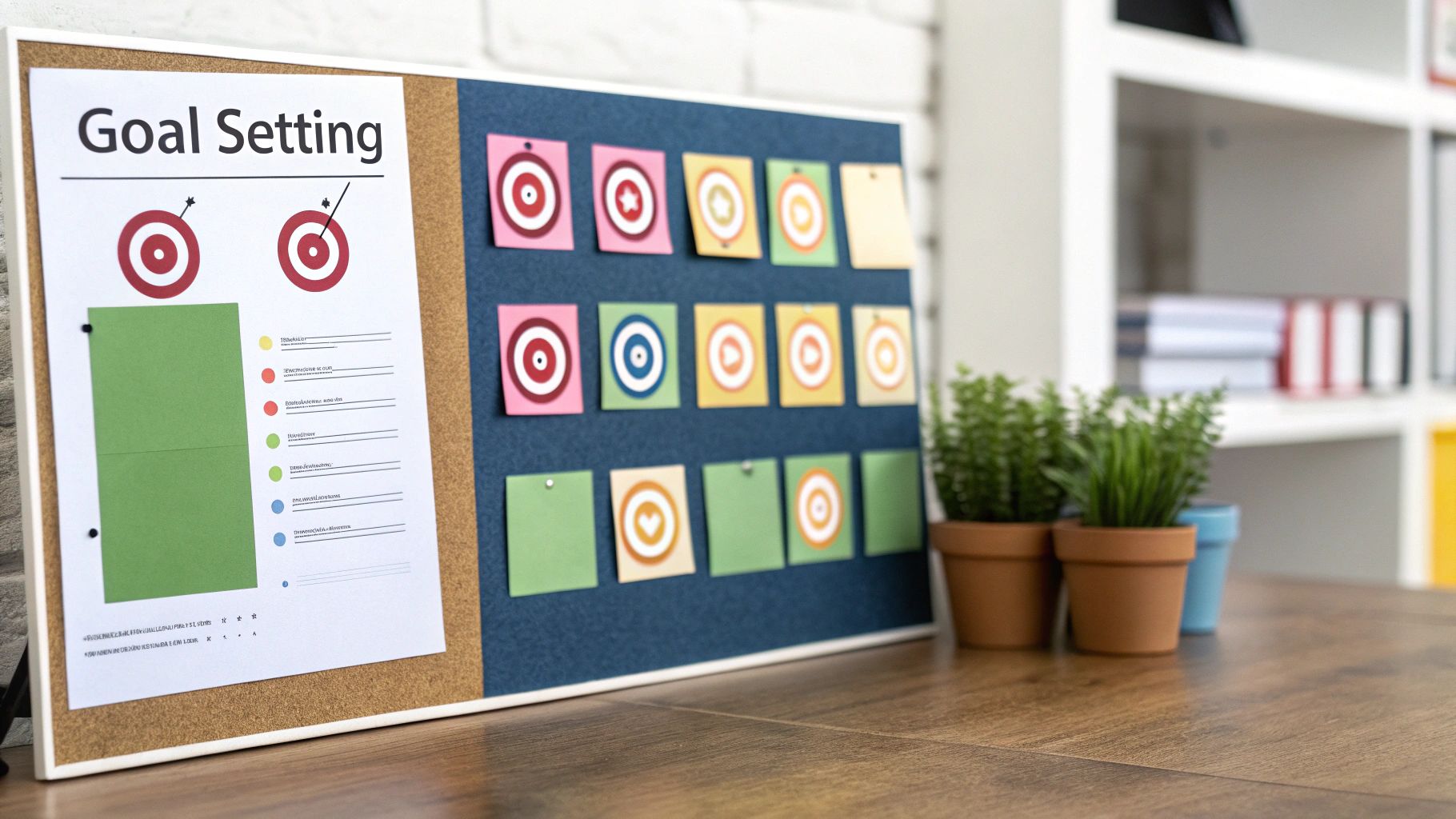
How to Get Rid of Writer's Block For Good
July 3, 2025
That gut-wrenching feeling of staring at a blank page, the cursor mocking you with its incessant blinking, is something every writer knows. It’s frustrating. It feels like a failure. But before you can break through it, you need to look past the symptom and find the source.
Figuring out how to beat writer's block starts with understanding why it’s happening in the first place.
Pinpointing the Real Cause of Your Writer's Block

Here’s the secret: Writer's block is almost never about a true absence of ideas.
It's actually a protective mechanism. Your brain is hitting the emergency brake because the perceived stakes feel too high, or something deeper is off-kilter. The key is treating the cause, not just the symptom of being unable to write.
The Most Common Culprits
Think of "writer's block" as a catch-all term for several different conditions that all share one symptom: you can’t write. Naming your specific ailment is the first step toward finding the right cure.
Most of the time, the problem can be traced back to one of these four areas:
- Perfectionism: This is that intense, paralyzing pressure to make every single word flawless from the get-go. You’re so afraid of not meeting an impossibly high standard that you can't even start.
- Fear and Anxiety: This isn't just about the work. It’s the fear of failure, of what others will think, or even the fear of success and the expectations that follow. It's that nagging voice asking, "What if this just isn't good enough?"
- Creative Burnout: You've simply run the tank dry. This is what happens when you’re constantly producing without taking time to refill your creative well with rest, new experiences, or even just reading for fun.
- Lack of Clarity or Motivation: Sometimes, you're stuck because the project’s goal is fuzzy, or you’ve lost touch with why you started it. Without a clear purpose, it’s almost impossible to stay motivated.
This struggle, which experts sometimes call 'creative inhibition,' isn't new. Its recognition has grown over the centuries, becoming a well-known affliction in American culture after gaining prominence with French Symbolists and authors of the great American novel. The roots are varied—from a simple lack of inspiration to more serious issues like depression, financial stress, or anxiety over failure. If you're curious, you can explore a deeper historical analysis of writer's block to see how our view of it has changed.
Key Takeaway: Writer's block isn’t a single problem—it’s a symptom. It could be your inner critic working overtime, your creative energy tank running on empty, or a genuine fear of the outcome.
To move forward, you have to play detective.
Do you feel a wave of anxiety every time you open the document? That points to fear. Do you spend an hour rewriting the same sentence? Classic perfectionism. Do you just feel drained, uninspired, and completely disconnected from your work? That sounds a lot like burnout.
Each diagnosis requires a different prescription. Once you know what you’re really up against, you can start fighting back.
2. Actionable Ways to Break Creative Paralysis Now
When you’re staring at that blinking cursor and the words just won’t come, you don’t need a five-year plan. You need an emergency toolkit. Creative paralysis calls for immediate, practical action—anything to jolt your brain out of that frozen state and get something on the page.
Here’s the thing: you don't need a flash of divine inspiration. You just need to trick your brain into moving again. Simple, low-pressure techniques are your best friend here. They work by lowering the stakes and silencing that internal editor screaming at you to be perfect.
Sometimes the block isn't even in your head; it's in your room. A messy desk can absolutely reinforce a cluttered mind, making it even harder to focus. Clearing your physical space is often the first step to creating mental clarity.
This is a great visual reminder of how a simple environmental reset can kickstart creativity.

Creating a designated, intentional zone for your work has a powerful psychological effect. It's a signal to your brain that it’s time to switch gears and focus.
Quick-Start Techniques for Unblocking Your Mind
When you feel stuck, different tactics work for different moods. If you're overwhelmed, you need simplicity. If you're bored, you need novelty. Here are a few immediate techniques you can use, matched to the feelings that often come with writer's block.
| Feeling | Technique | How It Works |
|---|---|---|
| Overwhelmed | The Pomodoro Technique | Work in focused 25-minute sprints. The short burst feels manageable and builds momentum. |
| Perfectionist | 10-Minute Freewrite | Write nonstop for 10 minutes. The only rule is you can't stop. It bypasses your inner critic. |
| Anxious | Change Your Tools | Switch from your laptop to a pen and paper. The physical act uses a different part of your brain. |
| Bored | Change Your Scenery | Move to a coffee shop, a library, or even just another room. New sensory input sparks new ideas. |
These aren't about producing a masterpiece. They're about proving to yourself that you can still write. You can always fix a bad page, but you can’t edit a blank one.
Try a Low-Stakes Writing Sprint
One of the most reliable ways I break through a block is with a quick freewriting session. I set a timer for just ten minutes and write without stopping. The only rule is that my fingers have to keep moving. It doesn't matter if I end up typing "this is silly I don't know what to write" a hundred times. The point is to short-circuit that perfectionist paralysis.
The Pomodoro Technique is another lifesaver. It breaks your work into focused 25-minute intervals separated by short breaks. Knowing you only have to concentrate for a small chunk of time makes the whole task feel way less intimidating. It turns writing into a game and helps you build momentum, one little sprint at a time.
Key Insight: The goal of these sprints isn't to produce brilliant prose. It's to prove to yourself that you can still write. You can always edit a bad page, but you can’t edit a blank one.
Change Your Tools or Your Scenery
Sometimes the rut you're in is more physical than mental. If you’re sick of staring at a screen, grab a pen and a notebook you actually enjoy using. The simple act of writing by hand engages your brain differently and can unlock new thought patterns. I've even found that switching from a black pen to a blue one or changing the font I'm typing in can provide a tiny, but effective, mental reset.
A change of scenery is another incredibly powerful tool. Our brains build strong associations with our environments. If your desk has become a place of anxiety and frustration, it's time to leave it behind.
- Try a new location: A library, a bustling coffee shop, or even just a different chair in your house can work wonders.
- Get outside: Take your notebook to a park. The fresh air and different sensory inputs can be surprisingly effective at sparking new ideas.
- Redesign your space: You don't need a full renovation. Just moving a lamp or adding a new plant to your desk can make your writing zone feel fresh and inviting again.
For a deeper dive, our guide on finding the right writer's block help explores how to match the perfect solution to your specific problem. Ultimately, breaking creative paralysis often comes down to one simple thing: introducing a little novelty. By changing your process, your tools, or your location, you send a clear signal to your brain that it’s time to think differently.
Building Resilient and Sustainable Writing Habits

Quick fixes can get you through a tough afternoon, but the real secret to beating writer's block for good is playing the long game. Lasting solutions aren't about magic tricks. They're about building a creative practice that can withstand pressure and keep you moving forward, even on the days when it feels impossible.
This means designing a writing routine that fits your actual life—not some idealized version of a writer you saw in a movie. It’s about creating an ecosystem where your creativity thrives consistently, making the block an infrequent visitor instead of a permanent roommate.
If you've been there, you're in good company. Writer's block is a huge hurdle for professionals and hobbyists alike, with some studies suggesting that up to 80% of writers have faced it. For many, it's more than just frustration; one study found 80% of writers linked the condition to an affective disorder, which speaks to its serious psychological toll. You can read the full study on the psychological impact of writer's block.
Set Tiny, Unbreakable Goals
Momentum is your most powerful ally here. The best way to build it is by setting small, non-negotiable goals that feel almost too easy to skip. Forget trying to write a whole chapter or a thousand-word article every day. Instead, commit to something ridiculously achievable.
Here are a few ideas for micro-goals:
- Write just 150 words. That's it. Roughly three short paragraphs.
- Set a timer for 15 minutes. Write until it goes off, then you're done for the day.
- Complete one specific micro-task. Maybe it's just outlining a single section or writing one character's dialogue.
The goal isn't the word count; it's the act of showing up. By consistently hitting a tiny target, you're rebuilding trust in your own process. You're proving to yourself, day after day, that you are a writer who writes.
This approach transforms writing from a monumental task into a manageable daily habit. It lowers the barrier to entry so much that your excuses just start to fade away. After all, anyone can find 15 minutes.
Actively Refill Your Creative Well
You can't expect to constantly pour words onto a page without refilling your own creative reserves. Burnout is a primary cause of writer’s block, and it happens when you're all output and no input. Your creativity needs fuel.
Making time to actively seek inspiration isn't procrastination; it's a vital part of your job as a writer. Think of it as investing in your most important tool: your mind. To build a sustainable practice, you need to actually schedule "refill" time.
How to Refill Your Well
| Inspiration Source | Actionable Example |
|---|---|
| Reading Widely | Read outside your genre. If you write thrillers, pick up a biography or a book on science. |
| Visual Art | Visit a local museum, browse a photography website, or watch a visually stunning film. |
| New Experiences | Take a different route home, try a cooking class, or strike up a conversation with a stranger. |
By building these small habits, you’re creating a resilient system. You're teaching your brain that writing is just a normal part of your day, not some high-pressure performance. You'll also want to check out our complete guide on developing effective writing strategies that can help you maintain this creative flow over the long haul.
Adopting a Mindset That Encourages Creativity
More often than not, the real fight against writer's block happens between your ears. You can try every productivity hack in the book, but if you’re staring at the page with a sense of dread, you’ll stay stuck. The single most effective way to beat this for good is to completely reframe how you think about writing itself.
What does that look like? It means turning that intimidating blank page from a high-stakes final exam into a low-pressure sandbox. Your goal isn’t to write something perfect. It’s just to write something. Give yourself permission to be messy, to get it wrong, and to sound human.
This isn’t just you, by the way. The struggle is universal. It’s a deeply personal battle that can stall creativity and crater your confidence. If you want to see just how common this feeling is, you can explore the misery of writer's block through other writers' experiences.
Embrace the Shitty First Draft
Author Anne Lamott gave writers a gift when she coined the term "shitty first draft." It’s a liberating concept that grants you permission to just… write badly. The only goal of a first draft is to get the ideas out of your head and onto the page.
Think of it like a sculptor. They start with a lump of clay, not a finished statue. The first draft is your lump of clay. It’s supposed to be a mess. You can't shape, refine, or polish an empty pedestal.
Key Takeaway: The first draft is for you. The editing is for your reader. When you try to do both at once, you freeze up. Just get the clay on the table.
This one mental shift changes everything. It tells your inner critic to take a seat because it’s not their turn yet. Your job is simply to make a mess. You can always clean it up later.
Separate Your Creator Brain from Your Editor Brain
To take that idea a step further, you need to learn how to compartmentalize. Most writers get stuck because they try to create and edit at the exact same time—a surefire recipe for disaster.
Think of it as two different modes:
- The Creator Brain: This is your imaginative, idea-generating self. It’s playful and curious. It couldn’t care less about spelling or perfect punctuation. Its only job is to explore and connect dots.
- The Editor Brain: This is your logical, analytical self. It’s a meticulous critic that lives for refining, clarifying, and polishing the raw material your Creator Brain churned out.
Using both at once is like driving with one foot slammed on the gas and the other on the brake. You’ll just burn out the engine without going anywhere.
So, when you sit down for that first draft, make a conscious pact with yourself to only use your Creator Brain. Ignore the impulse to fix typos or rephrase sentences. Set a timer and just write. Once you have that raw material down, then you can unleash your Editor Brain. It will be much happier—and more effective—when it has something tangible to work with.
Creative Exercises to Reignite Your Inspiration

When your analytical mind has you completely tied up in knots, the best way out is often to sidestep it altogether. Forget about forcing your main project for a minute. Instead, jumpstart your creative engine with some low-stakes, playful exercises.
The goal here isn't to produce a masterpiece. It's simply to reconnect with the joy of creating.
Think of it as stretching before a workout. These little games warm up your creative muscles, making it that much easier to get back to the main event. They lower the pressure and remind you that writing can actually be fun—something we all tend to forget when a deadline is breathing down our necks.
Object Monologues and Scenario Starters
One of my favorite tricks for breaking a mental logjam is to shift my perspective completely. When you stop trying to pull ideas from your own tired brain, you open yourself up to something new. The easiest way to do that? Borrow the perspective of something—or someone—else.
It immediately removes the personal pressure and turns writing back into a game.
Try giving a voice to an inanimate object on your desk. What would your coffee mug complain about? What secrets has your keyboard overheard? This is called an "object monologue," and it’s a brilliant way to unlock fresh language and unexpected angles.
Scenario-based prompts work just as well. They give you a starting point, so you don’t have to face the absolute terror of a blank page.
- Scenario 1: Your main character gets a cryptic text from their future self. What does it say?
- Scenario 2: Write a conversation between two people who are talking about two completely different things.
- Scenario 3: Describe a familiar place, like your kitchen, but from the perspective of someone seeing it for the very first time.
These exercises are all about generating raw material. Quality is irrelevant. The act of creating is everything. Once you get a few paragraphs down, you’ll likely find it much easier to pivot back to your real project. If you're looking for more ways to build interesting scenes, our guide on how to write compelling content has a few more tricks up its sleeve.
Engaging Your Senses
Writer’s block often happens because we're stuck in our own heads, thinking in abstractions. The most powerful antidote is to ground yourself in the physical world by focusing on sensory details. It’s a practice that forces you to observe and describe things with fresh eyes.
Instead of thinking logically, try to answer a weird, sensory-based question. This is how you push past clichés and into more specific, imaginative territory.
Key Insight: When logic fails, lean on your senses. Answering a strange sensory prompt can unlock creative pathways your analytical mind keeps blocked. It’s not about finding the "right" answer, but about exploring the question.
Here are a few prompts designed to engage your senses and sidestep that inner critic who's causing all the trouble:
- What does forgiveness sound like?
- What is the texture of a secret?
- What color is the feeling of ambition?
- What does nostalgia smell like?
There are no wrong answers here. Just write whatever comes to mind for ten minutes, no judgment allowed. The entire point of these exercises is to trick yourself into writing. By making the task playful and absurd, you strip away the fear of failure and rediscover how fun it is to just put words on a page.
Got Questions About Writer's Block? Let's Clear a Few Things Up.
When you’re staring at a blank page, wondering how you’ll ever fill it, a lot of questions pop up. It’s natural. Understanding the beast you’re wrestling with is the first step toward getting it out of your way.
Let's tackle a few of the most common questions. Getting some clarity here can make the whole thing feel a lot less intimidating.
Is Writer's Block a Real Medical Condition?
The short answer? No. While the frustration, anxiety, and self-doubt are incredibly real, writer's block is not an officially recognized medical or psychological disorder in clinical manuals like the DSM-5.
Instead, it’s better to think of it as a symptom of other, very real issues.
Think of it like a fever. A fever isn't the illness itself; it’s just a signal that your body is fighting off an infection. In the same way, writer's block is a flashing red light telling you something else is going on under the surface. It could be burnout, crippling perfectionism, or just plain old performance anxiety.
Key Insight: Calling it a "block" makes it sound like a giant, immovable wall. It’s more helpful to see it as a temporary state caused by specific, solvable problems. This is a creative challenge, not a permanent diagnosis.
How Long Can This Last?
Ah, the million-dollar question. And the answer is, frankly, a frustrating one: it depends. A bout of writer's block can stick around for a few hours, a few days, or in some tough cases, even years.
How long it lasts is almost always tied to what’s causing it in the first place.
A short-term block might just be your brain telling you to take a walk or switch up your environment. But a longer, more stubborn block often points to deeper issues—maybe you’ve lost faith in the project, you’re dealing with major life stress, or your self-doubt has taken over the driver's seat.
Do AI Writing Tools Help or Hurt?
This is a new one, and it’s a good question. Artificial intelligence has thrown a fascinating wrench into this age-old struggle. Whether AI tools help or hurt really comes down to how you use them.
How AI Can Help: When you're feeling completely empty, AI can be a great creative partner. You can use it to brainstorm outlines, spitball different ways to phrase a sentence, or just generate some low-stakes writing prompts to get your fingers moving again. It's like having someone to bounce ideas off of when your own well has run dry.
How AI Can Hurt: The danger is over-reliance. If you start leaning on AI as a crutch to skip the hard work of thinking, your own creative muscles can get weak. You might find it harder and harder to generate original ideas on your own, creating a cycle of dependency that quietly chips away at your confidence.
The trick is to treat AI as a collaborator, not a replacement. Use it to spark an idea or get you over a specific hump, but always make sure your own voice, perspective, and critical thinking are running the show.
Ready to refine your drafts and ensure your writing sounds perfectly human? Natural Write can help you polish AI-generated text or your own rough drafts into clear, engaging content that bypasses AI detectors. Try Natural Write for free and see the difference.


